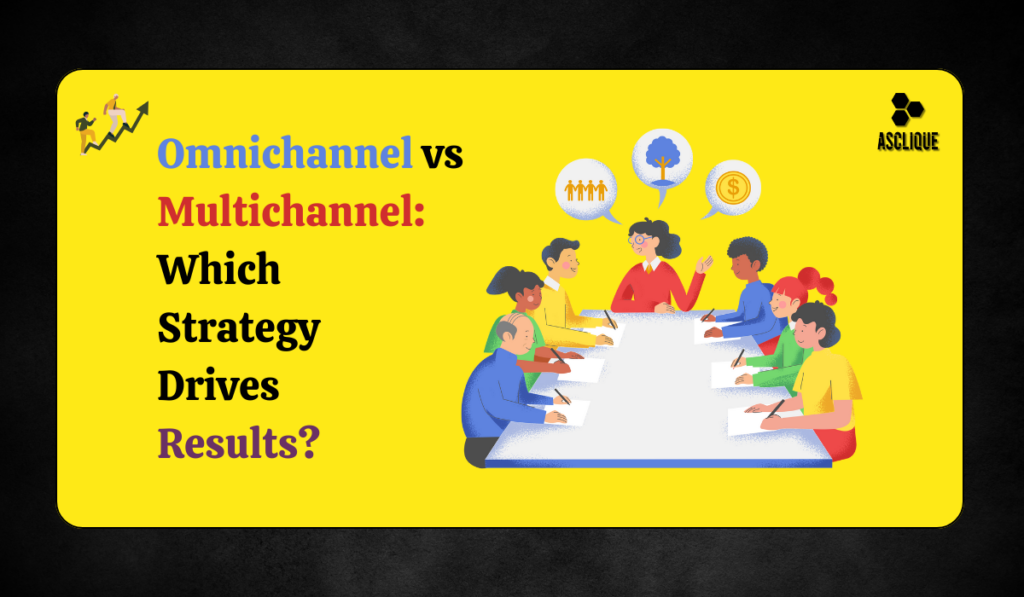Omnichannel vs Multichannel Marketing : While both strategies aim to reach customers across various touchpoints, the main difference is how these channels are integrated to enhance the overall customer experience.
Especially in this hyper-connected digital world of today, businesses can no longer afford to ignore any channel or platform when it comes to customers. Digital marketers, for instance, always seem to end up discussing two strategies: the omnichannel marketing or the multichannel marketing—that’s how they often refer to their rather complex attending to audiences. To both approaches as courses of option, much may be said in their favor. However, they also differ substantially with respect to customer experience, personalization, and engagement. Knowing that difference is essential to effectively arrange a marketing strategy that will connect with the customer and boost long-term success.
So, which one is better to continuously touch customers with? Let us first go through Omnichannel vs Multichannel Marketing.
What is Multichannel Marketing?
Multichannel marketing refers to the practice of using multiple marketing channels to reach customers. These channels can be email, social media, mobile applications, websites, direct mail, and even a physical storefront. The idea is to meet the customer where they are at and then engage the customer across many platforms.
Traditionally, however, in multichannel marketing, these channels work fairly independently of each other. Each platform functions in a silo, thus making customer experience frequently inconsistent. A customer might receive a special offer in an email, but if they go to the brand’s website or check its social media, the messaging might be contradictory. A fragmented set of marketing channels can confuse customers and break their willingness to engage with a brand in the long run.
What is Omnichannel Marketing?
In contrast, omnichannel marketing reaches beyond multichannel marketing, because it tries to make harmony among all channels. Obviously, customer experience is seamless and consistent at all points of contact: be it an online platform, a mobile app, or a brick-and-mortar store. The difference between Omnichannel vs Multichannel Marketing is set at an option where they be able to provide a connected and personalized experience so that customers identify at every stage of their journey.
The experiences became more continuous, such as sending emails offering products and using the same brand’s social images to see the same product featured in other places, and then being able to use the same discount found online in the physical store. It thus connected each interaction personalized and led to a fluid journey for the customer.
Omnichannel vs Multichannel Marketing

Though both strategies seek to engage customers through various channels, one method can prove to be far more effective than the other. This ambitiously aims to delineate the most important differences regarding Omnichannel vs Multichannel Marketing, especially in relation to customer engagement, customer experience, and personalization.
Customer Experience Consistency
- Multichannel Marketing: Each channel in multichannel marketing tends to operate in silos. All channels often adopt different and unique messaging, tone of voice, and offers, leading to inconsistency within the resulting customer experience – for example, a personalized email may be encountered by someone visiting a website hosting generic messages and vice versa.
- Omnichannel Marketing: The idea behind omnichannel marketing is that customers should find a seamless and consistent experience. Every kind of touch, whether customer engagement happens online or offline, communicates the same message, tone, and that all-important personalized content. Such customers could feel they have been interacting with the same “voice” and therefore have a high trust factor and increased customer satisfaction.
Personalization
- Multichannel Marketing: Personalization may be attempted in its own right in each channel, but it is normally confined to that platform. For instance, we can personalize an email, but that personalization does not often carry over whenever the consumer is engaging with your brand through social media or visits your website.
- Omnichannel Marketing: Omnichannel strategies are better suited to personalization. By integrating data from multiple touchpoints, brands enhance customer experience in real time at every step of the customer journey. When a product is viewed online and a cart is abandoned, a personalized email or notification with a discount offer or a gentle reminder will be sent. This personalized strategy increases engagement and subsequently conversion rates.
Engagement
- Multichannel Marketing: While multichannel marketing allows for broader customer reach, engagement can sometimes feel superficial. Since each channel operates independently, it can lead to fragmented experiences, where customers don’t feel a deep connection to the brand.
- Omnichannel Marketing: With omnichannel marketing, the experience is continuous and integrated, which leads to deeper engagement. By providing a smooth, personalized journey across all touchpoints, customers are more likely to stay engaged with your brand. A seamless transition from mobile to in-store, for instance, makes the entire experience more satisfying and encourages further interaction with your brand.
Data Consolidation
- Omnichannel Marketing: The data can be isolated on different platforms in multichannel marketing. Thus, the insights gained from one channel cannot be correlated with those from the other channels. As a result, you may end up losing chances to alter your messaging or comprehend the entire customer journey.
- Data Integration: Omnichannel marketing is based on an integrated database. Thus, it can monitor customer behavior across all channels and develop a complete customer profile. When marketers combine data from email campaigns, social interactions, and website interactions, they obtain a consolidated view of the customer, which helps them target audiences better and personalize their efforts to increase engagement and conversion rates.
Which Strategy Drives Better Engagement?
When it comes to engagement, omnichannel marketing clearly has the edge. Here’s why:
- Seamless Experience: Omnichannel marketing perfectly positions businesses to create an integrated, seamless customer journey that is devoid of friction. Customers want consistency and personalization, and they engage more over time.
- Deeper Personalization: Omnichannel marketing provides firms with opportunities to create deeply personalized experiences using data gathered from multiple touchpoints. Such personalization creates meaningful engagement that increases the chances for retention.
- Continuous Interaction: With an omnichannel marketing strategy, businesses interconnect all channels and engage customers in continuous conversations. This relationship continues building and strengthening customer loyalty, increasing lifetime value.
- Data-Driven Insights: Omnichannel platforms join together customer data from every engagement, allowing marketers to incorporate data-driven insights into their business decisions that improve engagement. The ability to tailor campaigns through the full customer journey (instead of just the isolated few) create more effective outcomes.
Popular Platforms for Each Strategy
Multichannel Marketing Platforms
HubSpot
It is a solid inbound marketing software that does keep a separate track of emails, content and social media.
Mailchimp
This direct email-marketing service integrates with social media, but treats these channels separately.
Hootsuite
Essentially it is a social media management tool that aids in managing campaigns across different platforms like Facebook, Instagram, and Twitter.
Omnichannel Marketing Platforms
Salesforce Marketing Cloud
Salesforce Marketing Cloud is an integrated all-encompassing platform that lets the business run integrated campaigns across various channels such as email, social media, mobile, and in-store touchpoints.
Klaviyo
It integrates email and SMS marketing so that businesses use customer behavior to personalize marketing across touchpoints.
Zendesk
A customer service platform with a seamless omnichannel integration offering email support, social media, live chat, and phone support.
Conclusion
Omnichannel marketing goes a step further from multichannel marketing regarding customer engagement by joining varied interactive touch points into one integrated, seamless, customized journey. Omnichannel marketing is all about data integration, relationship marketing messaging consistency, and the ability to provide customized experiences. This combined factor makes it far more engaging and fun.
If a company intends to create a deeper relationship with their customers toward long-term engagement, omnichannel is definitely the option to go. By providing a unified and personalized experience, brands will ensure that every interaction remains relevant to the audience, resulting in greater satisfaction, loyalty, and conversions.
If you wish to remain competitive in today’s landscape, finding some triggers that allow you to engage on an omnichannel platform will give you the edge to establish meaningful, lasting engagement. Understanding the differences between omnichannel and multichannel marketing, and how each impacts customer relationships or sustains engagement, will help you to choose wisely for your business growth.
FAQs
What’s the main difference between Omnichannel vs Multichannel Marketing?
Multichannel marketing uses multiple platforms independently, while omnichannel marketing integrates all channels to create a seamless, personalized customer experience.
Which is better for customer engagement?
Omnichannel marketing is better for engagement because it unifies and provides a consistent experience across every platform-they build stronger connections to customers.
Can I use both omnichannel and multichannel marketing?
Yes, companies can use both. Businesses can pursue wide outreach with multichannel, while omnichannel provides a seamless personalized experience to engaged customers.
What are some examples of omnichannel platforms?
Some well-known omnichannel platforms include Salesforce Marketing Cloud, Klaviyo, and Zendesk, which integrate customer data across all channels.
Is omnichannel marketing resource-intensive?
Yes, omnichannel marketing is generally resource-intensive for integration and platform management. Still, it stands to gain higher benefits in the long run in terms of customer loyalty.

